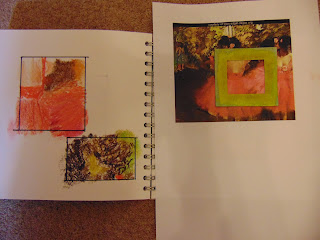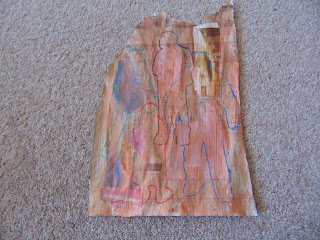I have a box of small pastels in a variety of colours, not necessarily my choice of colour but they are useful for various types of work. I also have a small quantity of soft pastels which I purchased some years ago for a particular project. In addition, I have a number of Markel sticks which I like as they can be used on fabric.
My first pages are using my box of colours to make marks using either the flat sides of the pastels or the sharper ends.
The bottom right is using one of my stencils with a brush.
I made three other stencils, a square, a triangle and a squiggle.
These top two pages are all pastels using a brush.
Here I have used Markel sticks. The squiggly piece is using the outside of the stencil as an outline.
Again, using the outside as an outline and on the right, including some solid inside stencils.
I then moved on to different papers.
This paper has acrylic paint on the background and although the piece on the left appeared to have lots of colour on, when I sprayed it with hairspray to set it, it just seemed to wash off. As it dried, the outlines became more apparent but the solid pastel had disappeared. The piece on the right, is done using Markel sticks but again, the colour didn't take too well on the acrylic paint.
This is Markel stick on black sugar paper.
I like this one. The background is wallpaper lining paper with a Koh-i-Nor paint wash. I used the inside and outside of the stencil with one of the small pastels. The colours have all blended well together making a delicate design. I used cotton wool to transfer the pastel to paper.
These two were done with the individual soft pastels. The top paper is almost like a fabric, I don't know what it is. It probably came in a shoe box. The bottom piece is a scrap of hand made paper from another project. I used cotton wool again which itself soaks up the pastel so you have to renew the colour for every line whereas with the Markel sticks you can get two or three lines from every application. The top paper certainly didn't take the colour quite as well as the bottom piece.
Degas.
I chose these four pictures that I found on the internet. The colours are all so different as is the intensity of the colour. I particularly like some of his backgrounds, you could certainly incorporate those into a piece of embroidery.
These are the pieces I selected from each picture. Where possible I have used the soft pastels that I bought seperately, the colours are much more subtle.
This lovely pale green colour with the reddish bodices goes so well together.
I liked the oranges and yellows here. There are some strong lines in the dress skirt and bodice that I tried to copy. I have also had a go at the background.
The shadows make the bodice look purple. I found it difficult to get the splashes of light onto the skirt. I think you must have to leave areas blank because using the white over the top doesn't work.
Here is all my work in my folder and my sketchbook cover appropriately decorated.
An interesting module, I am a bit intimidated by drawing people and yet, if you look very carefully at some of the great masterpieces you can spot mistakes like proportions being wrong but they don't notice because the piece as a whole is so beautiful. It still doesn't make me any more confident!
I did enjoy doing the chapter with masks and would still like to do an embroidered piece using that idea. The crowds worked out better than I expected and produced some surprising pieces.









































